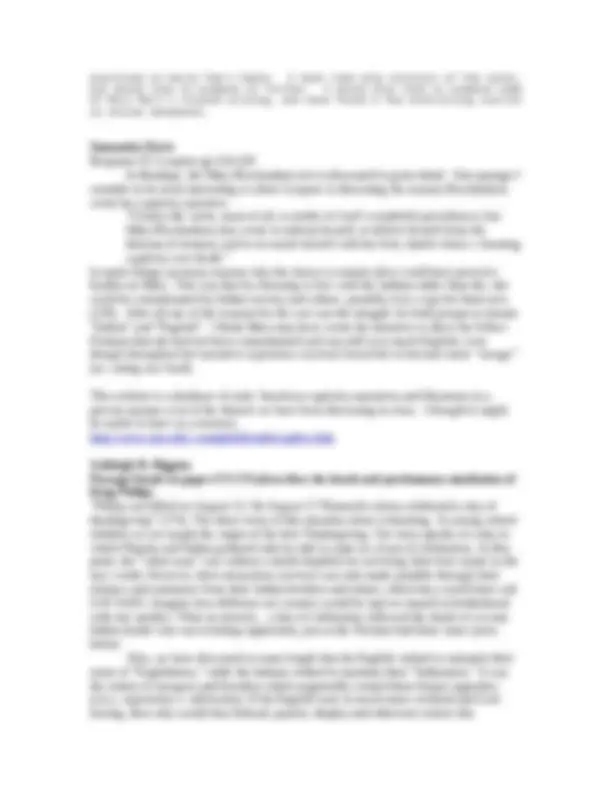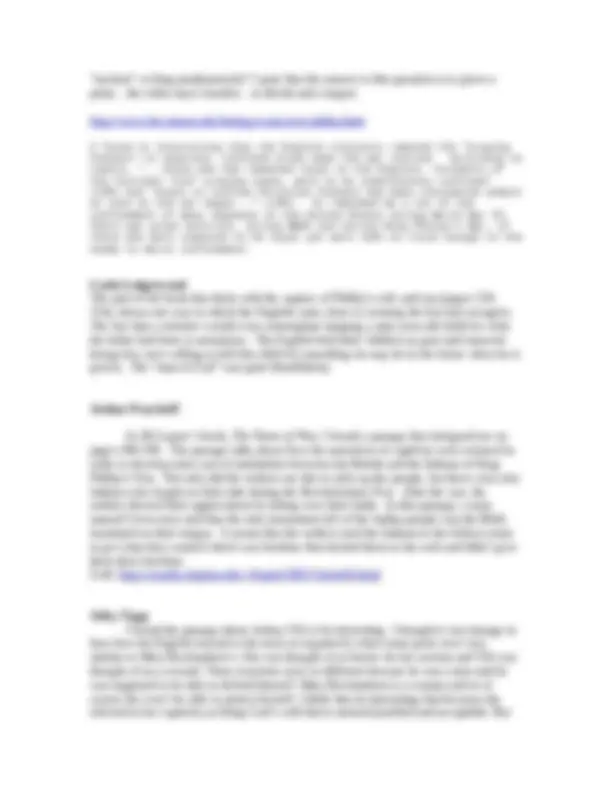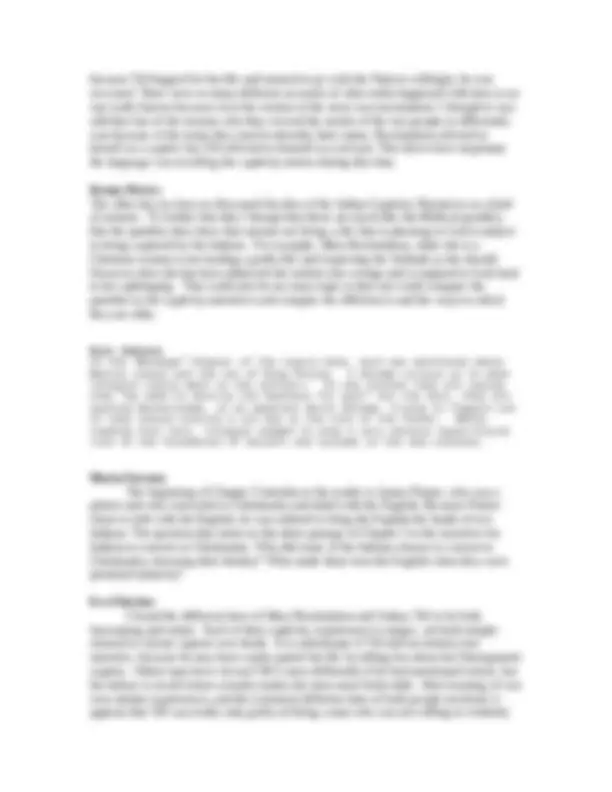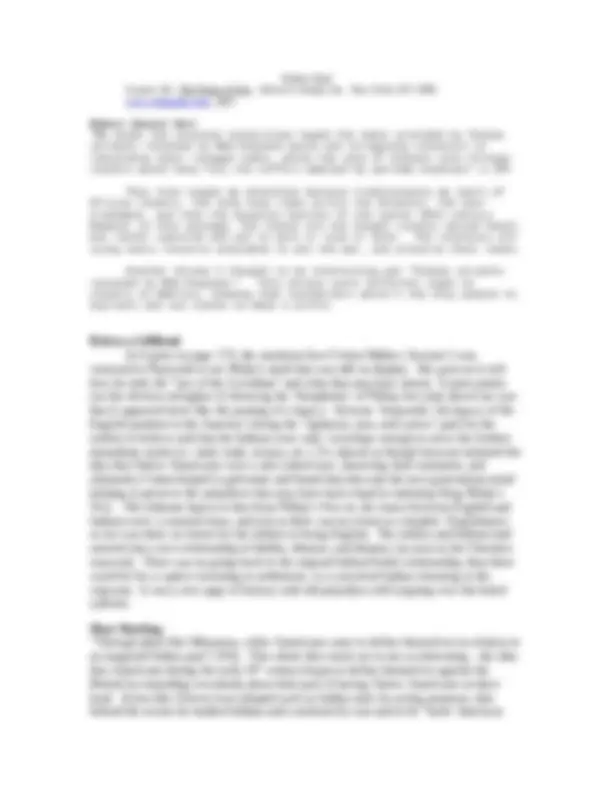







Study with the several resources on Docsity

Earn points by helping other students or get them with a premium plan


Prepare for your exams
Study with the several resources on Docsity

Earn points to download
Earn points by helping other students or get them with a premium plan
Community
Ask the community for help and clear up your study doubts
Discover the best universities in your country according to Docsity users
Free resources
Download our free guides on studying techniques, anxiety management strategies, and thesis advice from Docsity tutors
Material Type: Project; Class: Studies in American Culture; Subject: English; University: University of West Georgia; Term: Spring 2007;
Typology: Study Guides, Projects, Research
1 / 9

This page cannot be seen from the preview
Don't miss anything!






English/History 3300 Spring 2007 Patrick Erben Discussion Questions/Reading Response 3 January 30, 2007
Gerrit Breves The description in „The Name of War“ of the murder on Joshua Tift was one of the most shocking parts in this book. After reading this atrocity I had the feeling of scratching on the surface and I thought that I have to dig a little bit deeper to understand more of the Puritans behaviour. On the one hand were the Puritan’s outrages awful and bloody but imaginable in a war. On the other hand I never thought that Puritans would kill their own people just because they rather wanted to go in slavery or captivity than being slaughtered. Maybe this is only a conflict with my 21st^ century German ideology which rejects martyrdom respectively I’m not able to relate to. One can see a connection to some islamistic states, where people get murdered of their different religious views or just because they have another lifestyle (homosexual people who got hanged in Egypt). After a little research on the Internet to have a look on the Puritan’s point of view, I have to say that I don’t really understand them. Meanwhile the Puritans seem to me more than religious fanatics. Maybe this is a little bit far fetched but I want to express my thoughts:
Michelle LaFalce Jill Lepore quotes that I found interesting: “Indians’ main purpose of taking captives was to adopt new members into their communities; many captives, especially children, became thoroughly Indianized, living out their lives with their new Algonquian families and losing even the ability to speak English” (129). Maybe they were not barbaric after all!! “The colonists’ greatest anxiety, after all, was the fear that they were becoming Indianized” (129). BUT settlers main goal was to “Christianize” the Indians without regard to their existing culture. I find this entirely ironic!! “Twenty pounds bought her (Rowlandson’s) freedom; captivity saved her soul” (128). Why was Tift executed and interrogated after coming back to English society? I understand that it is because he “told his story to save his neck” and not to praise God and that he was found living with the Indians but it confuses me as to why he was killed when that seems like it would not be praised by God. Killing their own seems like it would be against what the Puritans believed spiritually, no matter what the case was. I also liked to read about James Printer and his story. I found it interesting that he was with Mary Rowlandson during her captive and actually served as a scribe during her negotiations for freedom. Mechelle Puckett Lepore, page 182. "Yet there is something deeply ambiguous in the early commemorations of King Phillip's War, the etching of it onto bodies and land. Displaying Phillip's skull seems to have kept the war alive as much as it put it to rest." In this phrase, Lepore contrasts with Elaine Scarry's thoughts on displaying artifacts of war. Scarry says the artifacts "document and reinforce(s) its ending." I agree more with Lepore on this issue. When the colonists looked at those artifacts, or the heads of dead natives, they may have initially though "thank goodness the war is over." However, for many, those artifacts brought back feelings of anguish over lost ones, and feelings of anger and hatred toward the natives they were still surrounded by. Those artifacts exacerbated conditions between the colonists and the natives, because they were a direct connection to the heightened emotions people had about the war. They were also symbols of the colonists own savagery. For my research project, I mentioned to you that I would like to study the domestic situation of slaves in the 1800's. However, I looked a bit further into it over the weekend, and am now much more interested in studying the links between slavery and capitalism. Harriet Beecher Stow felt that slavery was directly linked to capitalism, and this was
“sachem” or king posthumously? I pose that the answer to this question is to prove a point…the white man’s burden…to divide and conquer. http://www.bio.umass.edu/biology/conn.river/philip.html I found it interesting that the English colonists removed the "praying Indians" to separate, confined areas when the war started. According to Lepore, "...those who had remained loyal to the English, residents of the fourteen "old" praying towns, were to be indefinitely confined" (138) and "plans to confine Christian Indians had been considered almost as soon as the war began..." (138). It reminded me a lot of the confinement of many Japanese in the United States during World War II. There was great mistrust, during WWII and during King Philip's War, of those who were supposed to be loyal yet were seen as close enough to the enemy to merit confinement. Carla Ledgerwood The part of the book that deals with the capture of Phillip’s wife and son (pages 150- 154), shows one way in which the English came close to crossing the line into savagery. The fact that a minister would even contemplate hanging a nine-year-old child for what his father had done is monstrous. The English held their children as pure and innocent beings but were willing to kill this child for something he may do in the future when he is grown. The “man of God” was quite bloodthirsty. Joshua Waychoff In Jill Lepore’s book, The Name of War , I found a passage that intrigued me on pages 186-190. The passage talks about how the narratives of captivity were reissued in order to develop some sort of similarities between the British and the Indians of King Phillip’s War. Not only did the settlers use this to rally up the people, but there were also Indians who fought on their side during the Revolutionary War. After the war, the settlers showed their appreciation by taking over their lands. In this passage, a man named Crevecoeur said that the only monument left of the Indian people was the Bible translated on their tongue. It seems that the settlers used the Indians to the fullest extent to get what they wanted which was freedom then kicked them to the curb and didn’t give them their freedom. Link: http://xroads.virginia.edu/~Hyper/CREV/letter04.html Abby Tapp I found the passage about Joshua Tift to be interesting. I thought it was strange to hear how the English reacted to his story so negatively when some parts were very similar to Mary Rowlandson’s. She was thought of as heroic for her actions and Tift was thought of as a coward. There reactions were so different because he was a man and he was supposed to be able to defend himself. Mary Rowlandson is a woman and so of course she won’t be able to protect herself. I think that its interesting that because she referred to her captivity as being God’s will that is seemed justified and acceptable. But
because Tift begged for his life and seemed to go with the Natives willingly, he was executed. There were so many different accounts of what really happened with him so no one really knows because even his version of the story was inconsistent. I thought it was odd that one of the reasons why they viewed the stories of the two people so differently was because of the terms they used to describe their status. Rowlandson referred to herself as a captive but Tift referred to himself as a servant. This shows how important the language was in telling the captivity stories during this time. Kenny Rivers The other day in class we discussed the idea of the Indian Captivity Narratives as a kind of sermon. To further this idea I though that these are much like the Biblical parables, like the parables they show that anyone not living a life that is pleasing to God is subject to being captured by the Indians. For example, Mary Rowlandson, while she is a Christian woman is not leading a godly life and respecting the Sabbath as she should. However after she has been abducted she realizes her wrongs and is inspired to look back to her upbringing. This could also be an essay topic in that one could compare the parables to the captivity narratives and compare the differences and the ways in which they are alike. Kyle Johnson In the "Bondage" Chapter of the Lepore book, much was mentioned about Native slaves and the son of King Philip. I became curious as to what religion really ment to the settlers. In one instant they are saying that "we need to destroy the heathons for god!" but the next, they are quoting Deuteronomy, in an apparent moral delima, trying to figgure out if they should exicute a son due to the sins of the father. While reading this text, religion seemed to play a very obvious hypocritical role in the foundation of beliefs and systems in the new colonies. Maria Fortson The beginning of Chapter 5 introduces the reader to James Printer, who was a printer and who converted to Christianity and sided with the English. Because Printer chose to side with the English, he was ordered to bring the English the heads of two Indians. The question that arises in this short passage of Chapter 5 is the incentive for Indians to convert to Christianity. Why did some of the Indians choose to convert to Christianity, knowing their destiny? What made them trust the English when they were promised amnesty? Eve Fletcher I found the different fates of Mary Rowlandson and Joshua Tift to be both fascinating and unfair. Each of their captivity experiences is unique, yet both simply seemed to choose capture over death. It is unfortunate if Tift told an entirely true narrative, because he may have easily spared his life by telling lies about his Narragansett captors. Others may have viewed Tift’s story differently if he had mentioned torture, but his failure to recall torture actually makes his story more believable. After learning of two very similar experiences, and the extremely different fates of both people involved, it appears that Tift was really only guilty of being a man who was not willing to violently
settlers such as Mathers and Fiske call the Indians savages and heathens but at the same time it was the settlers who took to Indians lands away. I also noticed on page 219 where “Dr. Mather” called King Philip a man of “cursed memory” because his war was brought up so many times in the play “Metamora”. I also noticed how King Philips War was used as “Propaganda” against the British. One could look back and see that the settlers treated the civilized Indians such as the Cherokee Indians in Georgia badly because of the Tear of Trails that so many died on traveling across the nation. One could research on surviving captivity from different Indian Tribes throughout of the area of were Mary Rowlandson lived. One could also give the view point of how the Indians were treated when captured by the settlers. Another view point could be how they had to survive being captured even though a majority of them were killed in the struggles of both sides. David Epps I wanted to comment on the passage in Lapore's work about the removal of the Cherokee Indians from their homes in our state of Georgia. (p.204) I felt like this was a good supporting idea for the theme of violence. It showed that in a time of conflict, innocent civilians are not safe from the horrors of violence. The removal of the Indians showed that though men fight in the battles, women and children are also threatened and can be subject to violence even if they don't participate in battle. Nicole Acosta What Does it Mean to be Redeemed? At the beginning of our reading for today I became perplexed about the idea of redemption. When speaking about the capture of Mary Rowlandson, Lepore says that Rowlandson was, “Redeemed by a twenty-pound ransom,” (125) and I asked myself what definition of redemption did Lepore intend? The biblical sense of the word means a savior by the grace of God, or, in the Christian sense it means to be specifically saved by Jesus. According to the definition from Wikipedia.com redemption is, “the payment of an obligation, as in a government's payment of the value of its bonds. In this sense, redemption can mean the payment of any formal obligation incurred by any business or institution,” (Wikipedia). In another reading, I might take the latter definition as face value for what Lepore meant, but seeing as Rowlandson was a minister’s wife and keeping in mind that Phillip’s war included much involvement with Christianity, the word redemption is entirely in conflict with the life of Mary Rowlandson. Even though Lepore is the author using the term redemption, she surrounds it in quotations as if she were paraphrasing Rowlandson’s story. If so, it is difficult to believe that Christians such as Rowlandson and her community would consider putting a price on redemption. The Indians who captured Rowlandson were considered savages so it does make sense that Rowlandson’s brethren would attempt a rescue, yet it seems that no matter when they rescued Rowlandson or the other captives, they would have already been imprinted with the Indian culture, as the Indians were by the Christian culture. Many Indians converted to Christianity and amongst them, Lepore mentions a man named Printer who was involved with the reinstating of Rowlandson to her society. Lepore explains that Printer would bring back the heads of opposing Indians as, “testements to his fidelity” (126). With Printer’s bounty emerges another conflict: why would someone have to prove their faith in Christianity by killing their fellow man? Did the Christians of this time completely overlook the part of the Christian story of Cain and Abel? And if so, was Printer considered redeemed by the Christian society? Redemption in Mary Rowlandson’s case now seems more confusing than ever. It is difficult to try and reason with the idea that it was just a payment and there were not any conflicting Christian ideas associated with her liberation from the Nipmuck Indians. In fact, after reading this, my idea of the use of redemption at the time is now foggier than it was before I started the reading assignment for today.
Works Cited Lepore, Jill. The Name of War. Alfred A. Knopf, Inc. New York, NY 1998. www.wikipedia.com, 2007. Robert Daniel Karr “No doubt the colonial authorities hoped the labor provided by Indian servants retained by New England would aid struggling colonists in rebuilding their ravaged towns, while the sale of Indians into foreign slavery would help fill the coffers emptied by wartime expenses” p. This line caught my attention because traditionally we learn of African slavery, the long ship rides across the Atlantic, the poor treatment, and then the equality battles of the latter 20th century. However in this passage, the slaves are not bought (unless second hand), but rather captured and put to work or sold or both. The colonists are using every resource available to win the war, and preserve their towns. Another phrase I thought to be interesting was “Indian servants retained by New England…” This phrase casts different light on slavery in America, showing that southerners weren’t the only people to buy/sell and use slaves to make a profit. Rebecca Gilliland In Lepore on page 174, she mentions how Cotton Mather, Increase’s son, ventured to Plymouth to see Philip’s skull that was still on display. She goes on to tell how he stole the “jaw of the Leviathan” and what that may have meant. Lepore points out the obvious metaphor of silencing the ‘blasphemy’ of Philip, but what struck me was that it appeared more like the passing of a legacy. Increase ‘bequeaths’ his legacy of the English position in the America’s being the ‘righteous, just, and correct’ path for the settlers to believe and that the Indians were only ‘sovereign enough to serve the Settlers immediate needs (i.e. land, trade, money, etc.). It’s almost as though Increase initiated the idea that Native Americans were a sub-culture/race, deserving their treatment, and ultimately Cotton helped to galvanize and brand that idea into the next generations mind helping to preserve the prejudices that may have had a hand in initiating King Philip’s War. The ultimate legacy is that from Philip’s War on, the issues between English and Indians were a constant issue, and just as there was no return to complete ‘Englishness’, so too was there no return for the settlers to being English. The settlers and Indians had entered into a new relationship of dislike, distrust, and distance (as seen in the Cherokee removal). There was no going back to the original Indian/Settler relationship, than there could be for a captive returning to settlement, or a converted Indian returning to the wigwam. It was a new page of history with old prejudices still reigning over the belief systems. Matt Sherling “Through plays like Metamora, white Americans came to define themselves in relation to an imagined Indian past” (193). This whole idea stuck out to me as interesting—the idea that Americans during the early 19th^ century began to define themselves against the British by reminding everybody about their past of having Native Americans on their land. Actors like Forrest even adopted such an Indian style for acting purposes, that behind the scenes he studied Indians and conclusively was said to be “more American